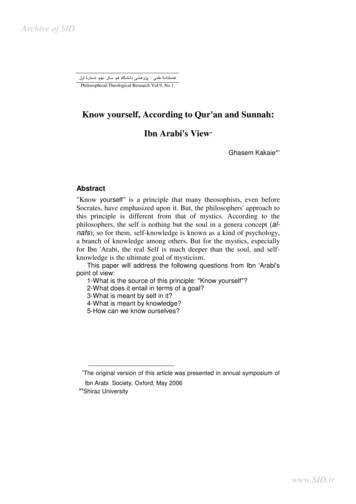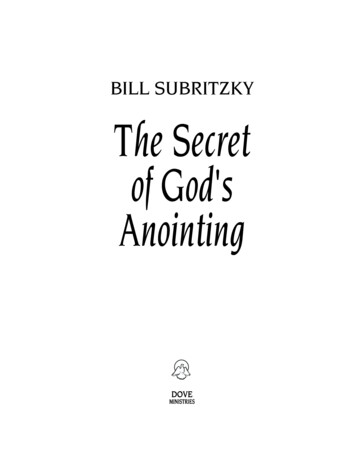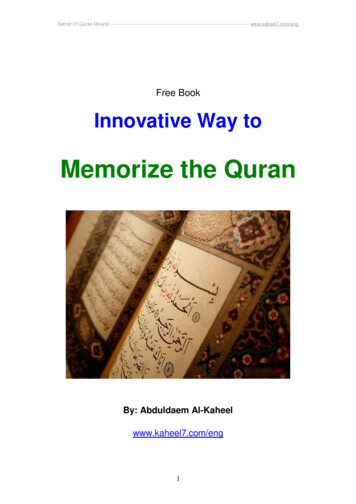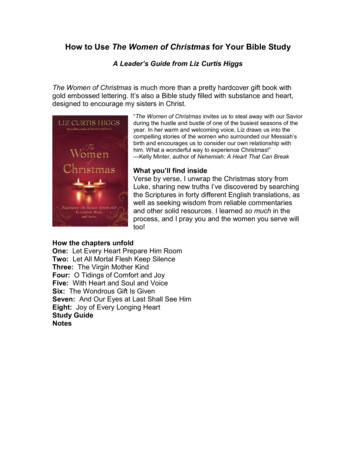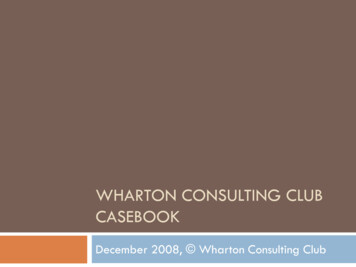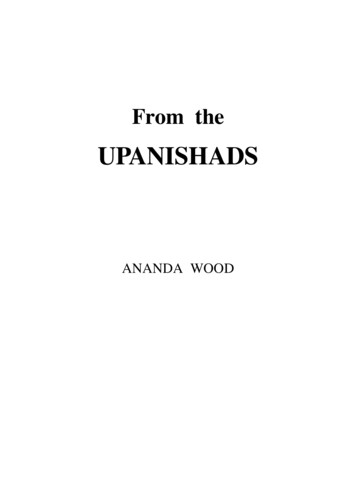
Transcription
GENEALOGY NOTESWhen Saying “I Do”Meant Giving Up YourU.S. CITIZENSHIPBy Meg Hacker
Nestled among the records from almost every fed eral court in America is a small body of recordsdocumenting women swearing allegiance to theUnited States—to be more accurate, re-swearing theirallegiance. When the massive amount of naturalizationrecords in the National Archives present similar infor mation—people pledging loyalty to America—what isspecial about this group?In line for a mar riage license, undated.With an act of 1907,women lost their U.S.citizenship when theymarried a foreigner.They had to reap ply for naturalization.Below: Amelia PizaniWestphal explainedthe reason for her ap plication in 1942.The women in these records were all born in America. Some most like ly never left this country, let alone their hometown, and yet they wereswearing allegiance back to the United States. Why would these womennot already be considered American?Since the earliest days of our nation, millions of people have gonethrough the process of becoming a U.S. citizen. Naturalization is achoice, not a requirement, and no rule mandates that one must completethe naturalization process once it has been started. There is also no regu lation promising the reinstatement of one’s lost American citizenship.At certain times in our country’s history, marriage—at least for thewoman—could affect one’s citizenship status. If an American womanmarried a foreigner before 1907 and the married couple continued toreside in the United States, she did not, because of her marriage, cease tobe an American citizen. The American woman remained a U.S. citizeneven after her marriage to a non-U.S. citizen.An act of March 2, 1907, also known as the Expatriation Act, changedall this. Congress mandated that “any American woman who marriesa foreigner shall take the nationality of her husband.” Upon marriage,regardless of where the couple resided, the woman’s legal identity morphedinto her husband’s.
If a (former) American woman’s alien husband becamea naturalized U.S. citizen after the marriage, she wouldregain her citizenship through the very husband withwhom she had lost it. If the same woman wanted herAmerican citizenship restored, and her husband had notnaturalized, she had to go through the entire naturaliza tion process as a true immigrant, with all of its standardrules and regulations.Even then, she was still tethered to her husband throughhis political or legal standing. If the United States, forwhatever reason, would not grant him citizenship, it wouldnot extend any repatriation opportunities to his wife.This inequity in citizenship rights prompted OhioCongressman John L. Cable to act. He sponsored leg islation to give American women “equal nationality andcitizenship rights” as men.The Cable Act (also known as the “Married Women’sIndependent Nationality Act” or the “Married Women’sAct”) passed on September 22, 1922, and repealed the1907 Expatriation Act.An American woman who married a non-U.S. citi zen after September 22, 1922, would no longer loseher citizenship if her husband was eligible to become acitizen. The Cable Act was great news for couples mar rying after 1922.Cable Act ConfusingFor Some WomenBut what about women who had already lost their citi zenship—what could they do? They would still have tofollow the full standard naturalization process.The Cable Act’s restrictions caused some confusion.A wife’s citizenship status no longer changed auto matically upon the husband’s naturalization—in fact, itdid not change at all. Some women who had marriedbefore passage of the act understandably believed theyhad either never lost their citizenship in the first place orassumed that they held the same status as their husbands(and, no doubt, children).After 1922, women who thought they had lost citi zenship by marriages due to the 1907 act had to file apetition for naturalization if they wished to regain it.To learn more about Women in naturalization records, go to /. Locations of and contact information for National Archives research facilities nationwide, go to www.archives.gov/locations/. Naturalization records in the National Archives, go to www.archives.gov/research/naturalization/.58 PrologueThe Cable Act of 1922 al lowed women to repatriateor reapply for their citizen ship. Betty Mundy certifiesher continuous residence inFlorida in her application re corded December 20, 1922,Spring 2014
Left: Martha Empey’sJuly 1939 applicationfor an oath of allegiancelists the documents shesubmitted,includingher birth and marriagecertificates and a copyof her divorce decree.Right: Yetta Ostrovskyapplied to take the oathof allegiance under theact of 1936. She lost hercitizenship through mar riage to a Russian na tional in Florida in 1919despite the fact thatshe had “resided con tinuously” in the UnitedStates since her birth.When Saying “I Do”A woman’s suitability for citizenship still depended onher husband’s status—he had to be “eligible” whether hewanted to swear allegiance or not.The act did not affect expatriated woman who had for mally renounced their citizenship by personally appear ing before a U.S. court. Nor did it affect women whohad become naturalized under the laws of another coun try. In these cases, she remained a citizen of the othercountry. American men who expatriated themselves byswearing an allegiance to another nation during WorldWar I had it easier—they only had to file an oath of al legiance to restore their U.S. citizenship.The changing laws could cause unexpected citizenshipflip-flopping. John Henry Pengally arrived in New Yorkin 1914 from England and started his naturalization pro cess in 1916. According to his naturalization papers, hedivorced his first wife in 1919 and married Bertha AnnaHaak (born in Bayside, New York) sometime thereafter.Bertha Anna, upon this marriage, became a British subject.John Henry finally naturalized in September 1923—but what was the status of Bertha Anna? Because of theCable Act, she remained a British citizen who happenedto be married to an American citizen. Two years later,Bertha Anna naturalized and became a United Statescitizen.Another obstacle faced women who wanted to reclaimtheir American citizenship. The Cable Act permitted awoman who was living abroad and lost her citizenshipdue to the 1907 act to return to the United States toregain her citizenship. Due to the 1924 ImmigrationQuota Law, however, she would have to return to theUnited States as a quota immigrant. If the quota for herhusband’s country had been exhausted for that year, shecould not get a visa and therefore could not return to theUnited States to repatriate.A series of bills introduced in 1931 removed the re maining inequalities of the 1922 act: the ineligiblespouse clause and the foreign residency issues.Prologue 59
1940 Law: All WomenCan Regain CitizenshipAn act of 1936 provided marital expatriates—whosemarriages to aliens had ended through death or di vorce—with an opportunity to regain their lost citizen ship by filing an application. Upon approval, womencould resume citizenship simply by taking an oath ofallegiance. This act required the proof of her U.S. birthor naturalization as well as proof that the marriage hadended. Women flocked to the courts to file their appli cations. Women involved in ongoing marriages contin ued to file the regular paperwork for naturalization until1940.The act of July 2, 1940, provided that all women whohad lost citizenship by marriage could repatriate regard less of their marital status. They only had to take an oathof allegiance—no declaration of intention was required.But they still had to show that they had resided continu ously in the United States since the date of the marriage.How do you find these records? Since women couldrepatriate at any court—county, state, or federal—therecords could be anywhere. Some of the federal courtrecords have even been digitized and are available onNational Archives partner sites: Ancestry.com, Fold3.com, and FamilySearch.org.Repatriation records that have not been digitized arefound among the naturalization records in Records ofDistrict Courts of the United States, Record Group 21.The records cover the years 1939–1981 and are housedat National Archives locations across the country (a listof them is on the inside back cover of this magazine).The courts often kept the repatriation oaths separatefrom other naturalization records, and when they did,the series titles usually include the word “repatriation.”Examples of series titles include Applications to RegainCitizenship and Repatriation Oaths, NaturalizationRepatriation Applications, Naturalization RepatriationProceedings, Repatriation Cases, NaturalizationRepatriations of Native Born Citizens, RepatriationOrders, Repatriation Case Record, RepatriationCertificates, and Repatriate Oaths of Allegiance.Once all of the repatriation oaths are digitized and up loaded onto our partner sites, searching for these womenshould become much easier. Until then, keep in mindthat the federal courts across the nation maintained repa triation oaths in different ways: separately with an index;separately without an index; combined with all of thenaturalization records with an index; or combined withall of the naturalization records without an index.If you believe your ancestor repatriated and you can not locate her on our online partner sites, contact theNational Archives research facility responsible for thestate in which your ancestor resided. PAuthorMeg Hacker, a Prologue contributing editor, hasbeen with the National Archives at Fort Worth since1985 and is now Director of Archival Operationsthere. She received her B.A. in American historyfrom Austin College and her M.A. in American History from TexasChristian University. Texas Western Press published her thesis, CynthiaAnn Parker: The Life and the Legend.The best place to start a search for women’s repatriation records is online. Several series ofrecords have been digitized and can be found in the National Archives Online Public AccessOpposite: MarionSteed’s petitionfor naturalizationprovides usefulfamily informa tion as well asher claim thatshe lost her U.S.citizenship whenshe voted in anelection in Sussex, England, inJuly 1945.When Saying “I Do”catalog and on our partner websites Ancestry.com, FOLD3.com, and FamilySearch.org.Keep in mind that the different sites will have different sets of records. On Ancestry, selectthe search category “immigration and travel.” On Fold3, select “non-military collections,”and then “naturalization petitions (1700–mid 1900s). On FamilySearch, you can choose afilter by collection after you have typed in the person’s name and dates.All of these online sources continually add material, so it helps to check regularly.Prologue 61
married a foreigner before 1907 and the married couple continued to . reside in the United States, she did not, because of her marriage, cease to . be an American citizen. he American woman remained a U.S. citizen . even after her marriage to a non-U.S. citizen. An act of March 2, 1907, also known as t

